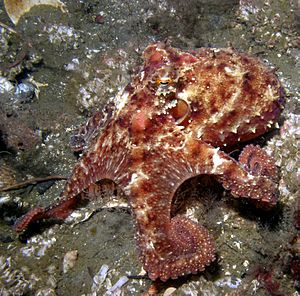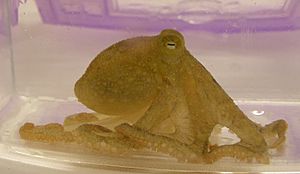Ruby octopus facts for kids
Quick facts for kids East Pacific red octopus |
|
|---|---|
 |
|
| Scientific classification | |
| Genus: |
Octopus
|
| Species: |
rubescens
|
| Synonyms | |
|
|

The East Pacific red octopus (scientific name: Octopus rubescens) is also known as the ruby octopus. It's a very common octopus found in shallow waters along the West Coast of North America. You can find it from the southern Gulf of California all the way up to the Gulf of Alaska. It might even live in the western Pacific Ocean.
This octopus lives in the intertidal areas (where the ocean meets the land) down to about 300 meters deep. It's a well-known bottom-dwelling hunter in these ocean habitats.
Meet the East Pacific Red Octopus
The East Pacific red octopus usually has a body (mantle) that is 8–10 centimeters (about 3–4 inches) long. Its arms can stretch out to 30–40 centimeters (about 12–16 inches). Adult octopuses typically weigh between 100–150 grams (about 3.5–5 ounces). However, some larger ones have been seen weighing up to 400 grams (nearly a pound!).
Like all octopuses, O. rubescens can change its color and skin texture. This means it can look very different depending on its mood or surroundings. Its color can range from a deep brick red to brown, white, or a mix of these colors.
It can sometimes be mistaken for young giant octopuses in the northern parts of its home range. But you can tell them apart! The East Pacific red octopus has three small, eyelash-like bumps (called papillae) just below its eyes. The giant octopus does not have these.
How Smart Are They?
Many scientists believe that octopuses, including the East Pacific red octopus, are among the smartest invertebrates. Invertebrates are animals without a backbone.
One cool sign of intelligence is having individual personalities. The East Pacific red octopus was the first invertebrate animal where scientists clearly showed that each octopus has its own unique personality!
What Do They Eat?
The East Pacific red octopus is a generalist hunter. This means it eats many different kinds of food. In labs, they have been fed various snails, bivalves (like clams), crabs, and barnacles.
Scientists haven't studied their wild diet much yet. But two studies in Puget Sound, Washington, found that they mostly eat snails. Their favorite snails include Nucella lamellosa and Olivella baetica. They also eat clams, scallops, and crabs. Even the tiny baby octopuses (larvae) have been seen eating krill in the wild.
When hunting, the octopus will pounce on its prey. As it catches its meal, it quickly changes its color in a special way. If it catches a bivalve, it often drills a small hole through the shell. This allows the octopus to inject venom, which makes it easier to open the shell and eat the prey. They often drill these holes near the bivalve's adductor muscles, which are what the bivalve uses to keep its shell closed.
A recent study suggested that O. rubescens might choose its food based on how much fat it can digest. This is different from just choosing food based on how many calories it has. If this is true, it means the octopus might be more of a specialist hunter than previously thought, focusing on specific nutrients.


